Cascaded Frequency Selective Surfaces with Matryoshka Geometry for Ultra-Wideband Bandwidth
Abstract
:1. Introduction
1.1. Review
1.2. Contributions
- Project, simulation, and validation of a cascaded FSS using matryoshka geometry, which is more efficient in cell dimensions in comparison with concentric square rings.
- Frequency response evaluation of the proposed structure in the band around 1.8 GHz.
- Dual-band operation with bandwidths that depend on the spacing between the FSS boards, one with a 1.2 GHz bandwidth in the 2 to 3.2 GHz range, for a spacing equal to 4 mm, and another with a 2 GHz bandwidth in the range from 1.8 to 3.8 GHz, for a spacing of 12 mm.
- Use of the negative geometry of a matryoshka geometry and its effect with the matryoshka in cascade.
2. Proposed Matryoshka Design
3. Measurement Setup
4. Results Analysis
4.1. Single-Layer FSS
4.2. Cascaded FSS
4.3. Comparisons of Experimental and Simulated Results
5. Conclusions
Author Contributions
Funding
Institutional Review Board Statement
Informed Consent Statement
Data Availability Statement
Conflicts of Interest
References
- Anwar, R.S.; Mao, L.; Ning, H. Frequency Selective Surfaces: A Review. Appl. Sci. 2018, 8, 1689. [Google Scholar] [CrossRef]
- Katoch, K.; Jaglan, N.; Gupta, S.D. A Review on Frequency Selective Surfaces and Its Applications. In Proceedings of the International Conference on Signal Processing and Communication (ICSC), Noida, India, 7–9 March 2019; pp. 75–81. [Google Scholar] [CrossRef]
- Kapoor, A.; Mishra, R.; Kumar, P. Frequency Selective Surfaces as Spatial Filters: Fundamentals, Analysis and Applications. Alex. Eng. J. 2022, 61, 4263–4293. [Google Scholar] [CrossRef]
- Bajaj, P.; Kundu, D.; Singh, D. Frequency Selective Surface-Based Electromagnetic Absorbers: Trends and Perspectives. Wirel. Pers. Commun. 2023, 131, 1881–1912. [Google Scholar] [CrossRef]
- Suri, A.; Jha, K. Active Frequency Selective Surfaces: A Systematic Review for Sub-6 GHz Band. Int. J. Microw. Wirel. Technol. 2023, 11, 1–15. [Google Scholar] [CrossRef]
- Tahseen, H.; Yang, L.; Zhou, X. Design of FSS-Antenna-Radome System for Airborne and Ground Applications. IET Commun. 2021, 15, 1691–1699. [Google Scholar] [CrossRef]
- Duan, Z.; Abomakhleb, G.; Lu, G. Perforated Medium Applied in Frequency Selective Surfaces and Curved Antenna Radome. Appl. Sci. 2019, 9, 1081. [Google Scholar] [CrossRef]
- Brandão, T.H.; Filgueiras, H.; Cerqueira, A.S.; Mologni, J.; Bogoni, A. FSS-Based Dual-Band Cassegrain Parabolic Antenna for Radarcom Applications. In Proceedings of the Conference 2017 SBMO/IEEE MTT-S International Microwave and Optoelectronics Conference (IMOC), Aguas de Lindoia, Brazil, 27–30 August 2017; pp. 1–4. [Google Scholar] [CrossRef]
- Chen, H.; Chen, H.; Xiu, X.; Xue, Q.; Che, W. Transparent FSS on Glass Window for Signal Selection of 5G Millimeter-Wave Communication. IEEE Antennas Wirel. Propag. Lett. 2021, 20, 2319–2323. [Google Scholar] [CrossRef]
- Dewani, A.A.; O’Keefe, S.G.; Thiel, D.V.; Galehdar, A. Window RF Shielding Film Using Printed FSS. IEEE Trans. Antennas Propag. 2018, 66, 790–796. [Google Scholar] [CrossRef]
- Amit, S.; Talasila, V.; Ramya, T.R.; Shashidhar, R. Frequency Selective Surface Textile Antenna for Wearable Applications. Wirel. Pers. Commun. 2023, 132, 965–978. [Google Scholar] [CrossRef]
- Li, Y.; Ren, P.; Xiang, Z. A Dual-Passband Frequency Selective Surface for 5G Communication. IEEE Antennas Wirel. Propag. Lett. 2019, 18, 2597–2601. [Google Scholar] [CrossRef]
- Kong, J.A. Electromagnetic Wave Theory; EMW Publishing: Cambridge, MA, USA, 2008. [Google Scholar]
- Murk, B.A. Frequency Selective Surfaces—Theory and Design; Wiley-Interscience: New York, NY, USA, 2000. [Google Scholar]
- Kushwaha, N.; Kumar, R. Design of a Wideband High Gain Antenna Using FSS for Circularly Polarized Applications. AEU—Int. J. Electron. Commun. 2016, 70, 1156–1163. [Google Scholar] [CrossRef]
- Chen, X.; Liu, T.; Zhang, W.; Guo, D.; Zhu, H. Design of Single-Layer Bandstop Fractal Frequency Selective Surface Based on WLAN Applications. Microw. Opt. Technol. Lett. 2024, 66, e33880. [Google Scholar] [CrossRef]
- Neto, J.J.G.P.; Campos, A.L.P.S.; de Lira, A.R.V.; Neto, A.G.; Silva, M.W.B. Absorb/Transmit Broadband Type Frequency Selective Surface. J. Microw. Optoelectron. Electromagn. Appl. 2023, 22, 1–12. [Google Scholar] [CrossRef]
- da Silva, F.C.G.; Campos, A.L.P.S.; Gomes, A.; de Alencar, O.M. Double Layer Frequency Selective Surface for Ultra Wide Band Applications with Angular Stability and Polarization Independence. J. Microw. Optoelectron. Electromagn. Appl. 2019, 18, 328–342. [Google Scholar] [CrossRef]
- da Silva Segundo, F.C.G.; Campos, A.L.P.S.; Neto, A.G. A Design Proposal for Ultrawide Band Frequency Selective Sur- face. J. Microw. Optoelectron. Electromagn. Appl. 2013, 12, 398–409. [Google Scholar] [CrossRef]
- Biswas, A.; Zekios, C.; Georgakopoulos, S. Transforming Single-Band Static FSS to Dual-Band Dynamic FSS Using Origami. Sci. Rep. 2020, 10, 13884. [Google Scholar] [CrossRef]
- Bilal, M.; Saleem, R.; Abbasi, Q.H.; Kasi, B.; Shafique, M.F. Miniaturized and Flexible FSS-Based EM Shields for Conformal Applications. IEEE Trans. Electromagn. Compat. 2020, 62, 1703–1710. [Google Scholar] [CrossRef]
- Wang, D.; Cai, B.; Yang, L.; Wu, L.; Cheng, Y.; Chen, F.; Luo, H.; Li, X. Transmission/Reflection Mode Switchable Ultra-Broadband Terahertz Vanadium Dioxide (VO2) Metasurface Filter for Electromagnetic Shielding Application. Surf. Interfaces 2024, 49, 104403. [Google Scholar] [CrossRef]
- Yunos, L.; Jane, M.L.; Murphy, P.J.; Zuber, K. Frequency Selective Surface on Low Emissivity Windows as a Means of Improving Telecommunication Signal Transmission: A review. J. Build. Eng. 2023, 70, 106416. [Google Scholar] [CrossRef]
- Ibrahim, A.A.; Mohamed, H.A.; Abdelghany, M.A.; Tammam, E. Flexible and Frequency Reconfigurable CPW-fed Monopole Antenna with Frequency Selective Surface for IoT Applications. Sci. Rep. 2023, 13, 8409. [Google Scholar] [CrossRef]
- Hussain, M.; Sufian, M.A.; Alzaidi, M.S.; Naqvi, S.I.; Hussain, N.; Elkamchouchi, D.H.; Sree, M.F.A.; Fatah, S.Y.A. Bandwidth and Gain Enhancement of a CPW Antenna Using Frequency Selective Surface for UWB Applications. Micromachines 2023, 14, 591. [Google Scholar] [CrossRef] [PubMed]
- Ud Din, I.; Alibakhshikenari, M.; Virdee, B.S.; Jayanthi, R.K.R.; Ullah, S.; Khan, S.; See, C.H.; Golunski, L.; Koziel, S. Frequency-Selective Surface-Based MIMO Antenna Array for 5G Millimeter-Wave Applications. Sensors 2023, 23, 7009. [Google Scholar] [CrossRef] [PubMed]
- Ren, J.; Wang, Z.; Sun, Y.-X.; Huang, R.; Yin, Y. Ku/Ka Band Dual-Frequency Shared-Aperture Antenna Array With High Isolation Using Frequency Selective Surface. IEEE Antennas Wirel. Propag. Lett. 2023, 22, 1736–1740. [Google Scholar] [CrossRef]
- Xi, S.; Xu, K.; Yang, S.; Ren, X.; Wu, W. X-band Frequency Selective Surface with Low Loss and Angular Stability. AEU—Int. J. Electron. Commun. 2024, 173, 154990. [Google Scholar] [CrossRef]
- Yong, W.Y.; Velkers, A.; Glazunov, A.A. Fully Metallic Frequency Selective Surface (FSS) Circular Polarizer Based on Cost-Effective Chemical Etching Manufacturing Technique. Electron. Lett. 2023, 59, 12982. [Google Scholar] [CrossRef]
- Zhang, C.; Liu, S.; Ni, H.; Tan, R.; Liu, C.; Yan, L. An Angle-Stable Ultra-Wideband Single-Layer Frequency Selective Surface Absorber. Electronics 2023, 12, 3776. [Google Scholar] [CrossRef]
- Chang, L.; Yang, X.; Liu, R.; Xie, G.; Wang, F.; Wang, J. FSS-TAG: High Accuracy Material Identification System Based on Frequency Selective Surface TAG. Proc. ACM Interact. Mob. Wearable Ubiquitous Technol. 2024, 7, 149. [Google Scholar] [CrossRef]
- Du, C.; Chen, H.; Wang, S.; Pang, Y.; Zhou, T.; Xia, S.; Zhou, D. Dual-Polarized Angle-Selective Surface Based on Double-Layer Frequency Selective Surface. Appl. Phys. Lett. 2024, 124, 111701. [Google Scholar] [CrossRef]
- Idrees, M.; He, Y.; Ullah, S.; Wong, S.-W. A Dual-Band Polarization-Insensitive Frequency Selective Surface for Electromagnetic Shielding Applications. Sensors 2024, 24, 3333. [Google Scholar] [CrossRef]
- Ahmad, R.; Zhuldybina, M.; Ropagnol, X.; Trinh, N.D.; Bois, C.; Schneider, J.; Blanchard, F. Reconfigurable Terahertz Moiré Frequency Selective Surface Based on Additive Manufacturing Technology. Appl. Sci. 2023, 13, 3302. [Google Scholar] [CrossRef]
- Li, Z.; Weng, X.; Yi, X.; Li, K.; Duan, W.; Bi, M. Design and Analysis of a Complementary Structure-Based High Selectivity Tri-Band Frequency Selective Surface. Sci. Rep. 2024, 14, 9415. [Google Scholar] [CrossRef] [PubMed]
- Xiao, L.-Y.; Cheng, Y.; Liu, Y.; Jin, F.; Liu, Q. An Inverse Topological Design Method (ITDM) Based on Machine Learning for Frequency Selective-Surface (FSS) Structures. IEEE Trans. Antennas Propag. 2024, 72, 653–663. [Google Scholar] [CrossRef]
- Lv, H.; Xiao, L.; Hu, H.J.; Liu, Q.H. A Spatial Inverse Design Method (SIDM) Based on Machine Learning for Frequency-Selective-Surface (FSS) Structures. IEEE Trans. Antennas Propag. 2024, 72, 2434–2444. [Google Scholar] [CrossRef]
- Neo, A.G.; D’Assunção, A.G., Jr.; e Silva, J.C.; Cruz, J.D.N.; de Oliveira Silva, J.B.; de Lyra Ramos, N.J. Multiband Frequency Selective Surface with Open Matryoshka Elements. In Proceedings of the 2015 9th European Conference on Antennas and Propagation (EuCAP), Lisbon, Portugal, 13–17 April 2015; pp. 1–5. [Google Scholar]
- de Sousa, T.R. Desenvolvimento de Superfície Seletiva em Frequência Baseada na Geometria Matrioska Independente da Polarização. Master’s Thesis, Federal Institute of Education, Science and Technology of Paraíba, Paraíba, Brazil, 2019. [Google Scholar]
- Neto, A.G.; Silva, J.C.; Coutinho, I.; Alencar, M.; Andrade, D. Superfície Seletiva em Frequência com Três Bandas de Rejeição com Aplicação à Faixa de 2,4 GHz. In Proceedings of the Conference: XXXVII Simpósio Brasileiro de Telecomunicações e Processamento de Sinais, Petrópolis, Brazil, 29 September–2 October 2019. [Google Scholar] [CrossRef]
- Neto, A.G.; Silva, J.C.; Coutinho, I.B.G.; Filho, S.S.C.; Santos, D.A.; de Albuquerque, B.L.C. A Defected Ground Structure Based on Matryoshka Geometry. J. Microw. Optoelectron. Electromagn. Appl. 2022, 21, 284–293. [Google Scholar] [CrossRef]
- AppCAD, Version 4.0.0; AppCAD. 2024. Available online: http://www.hp.woodshot.com/ (accessed on 1 February 2024).
- Ansys® HFSS, Release 18. 2024. Available online: https://www.ansys.com/products/electronics/ansys-hfss (accessed on 18 September 2024).
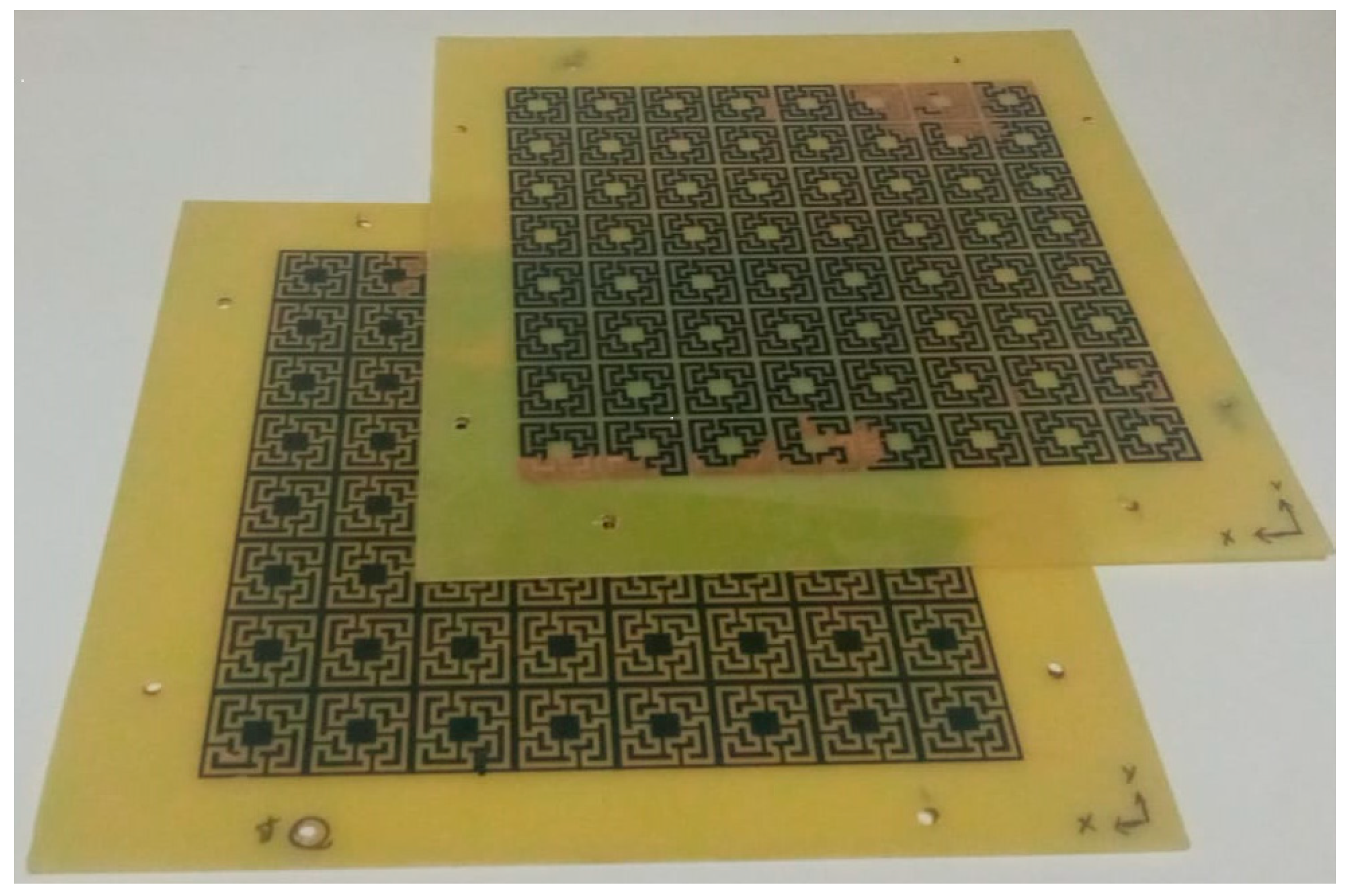
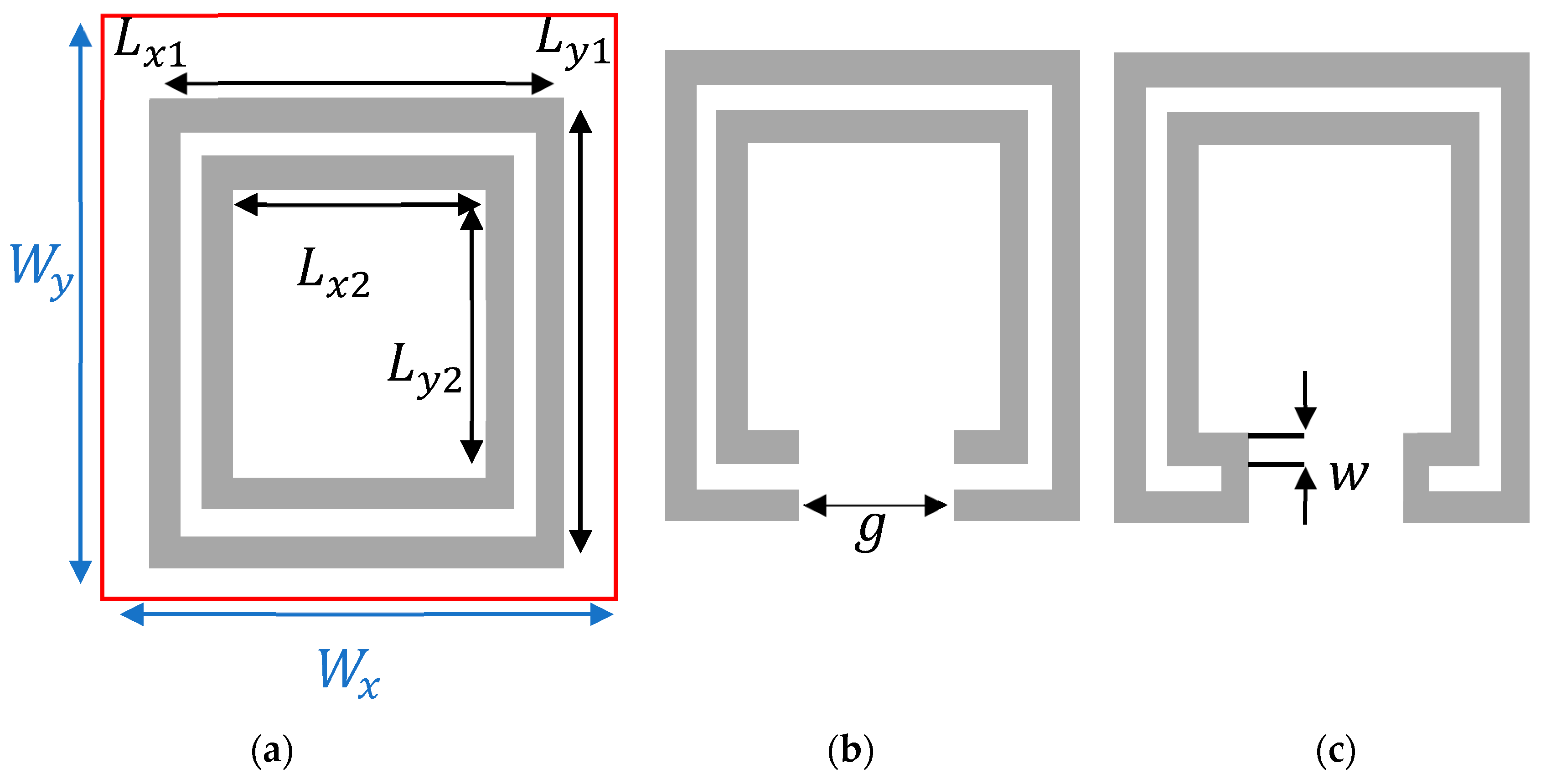
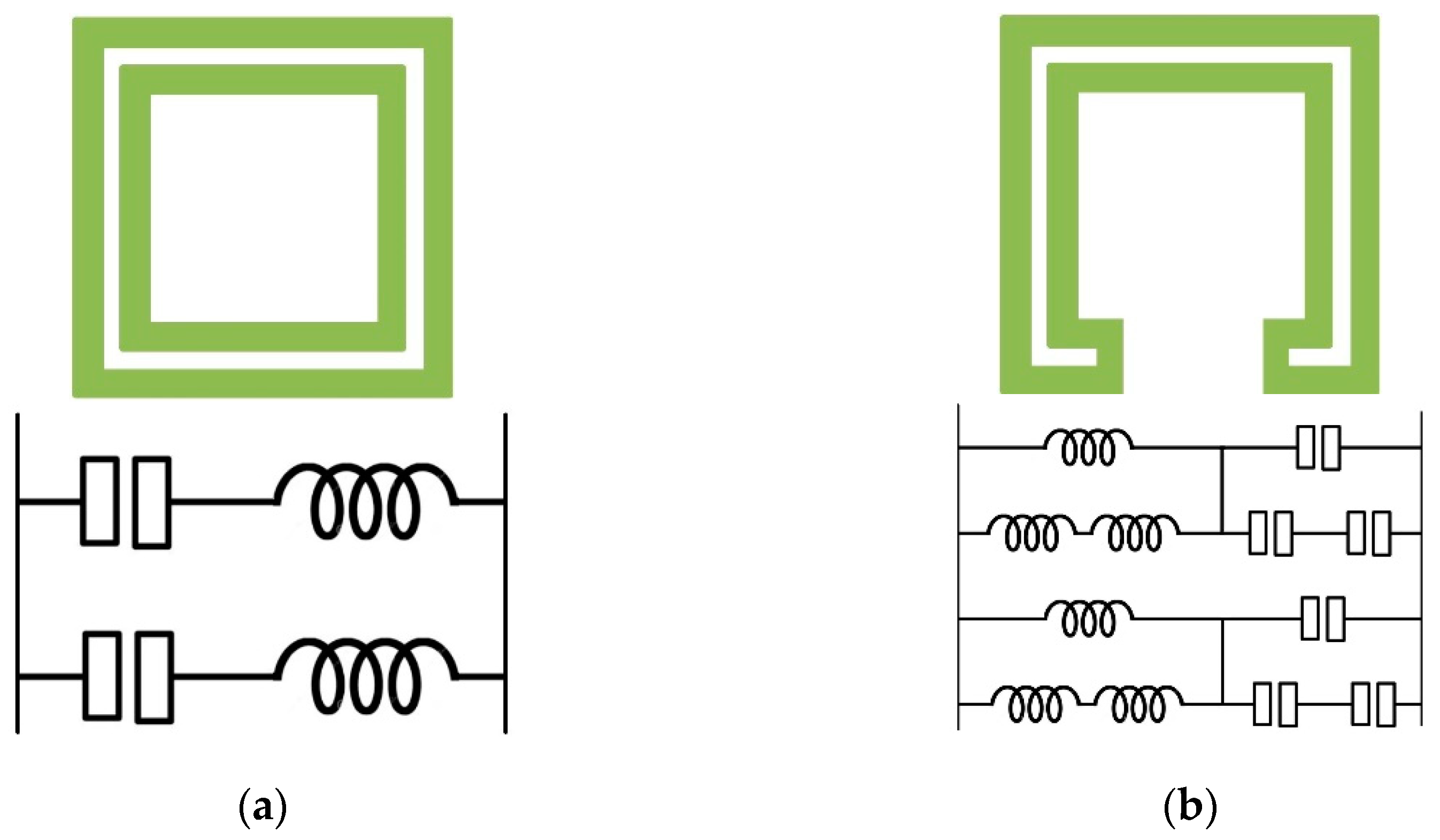
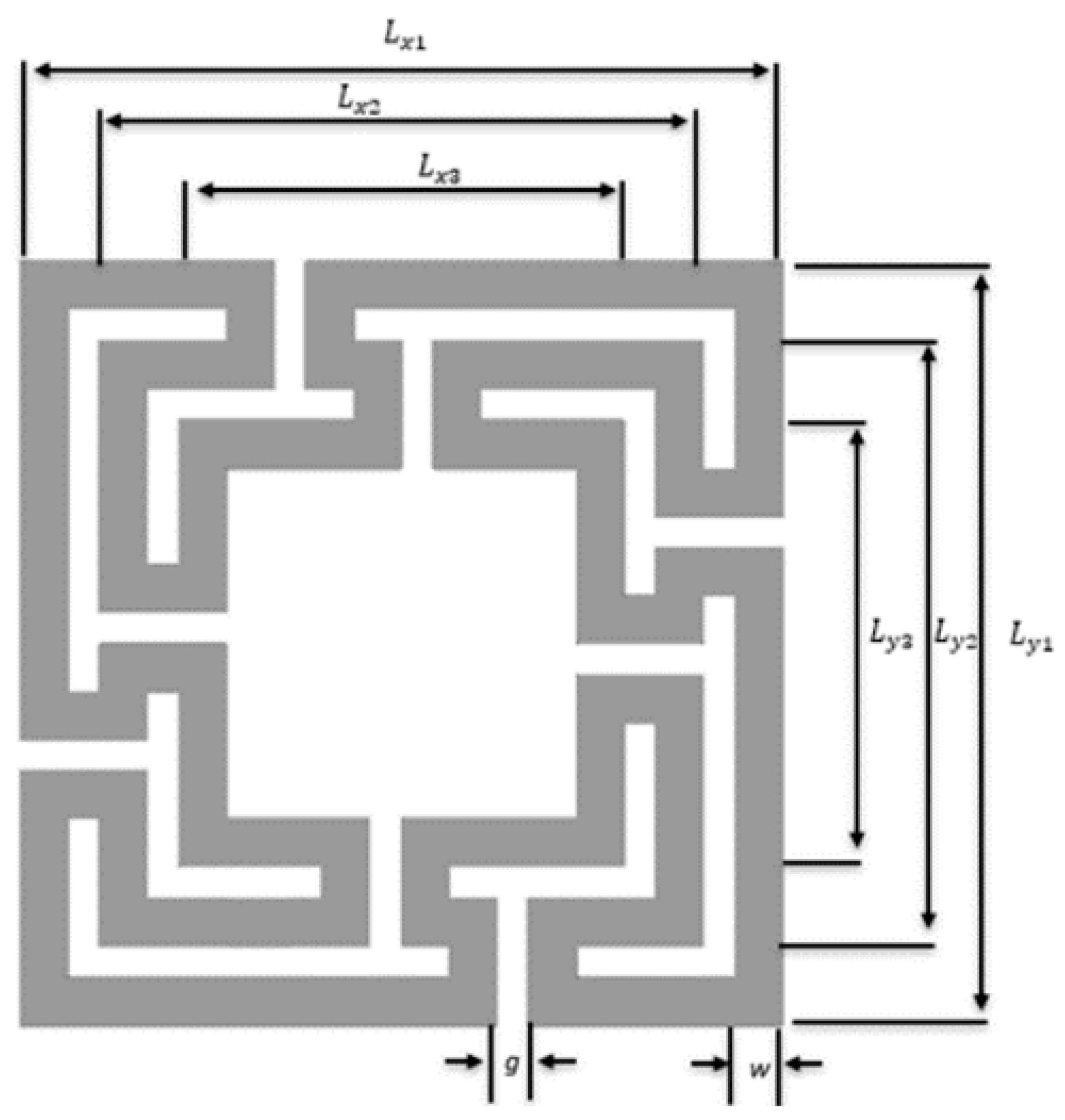
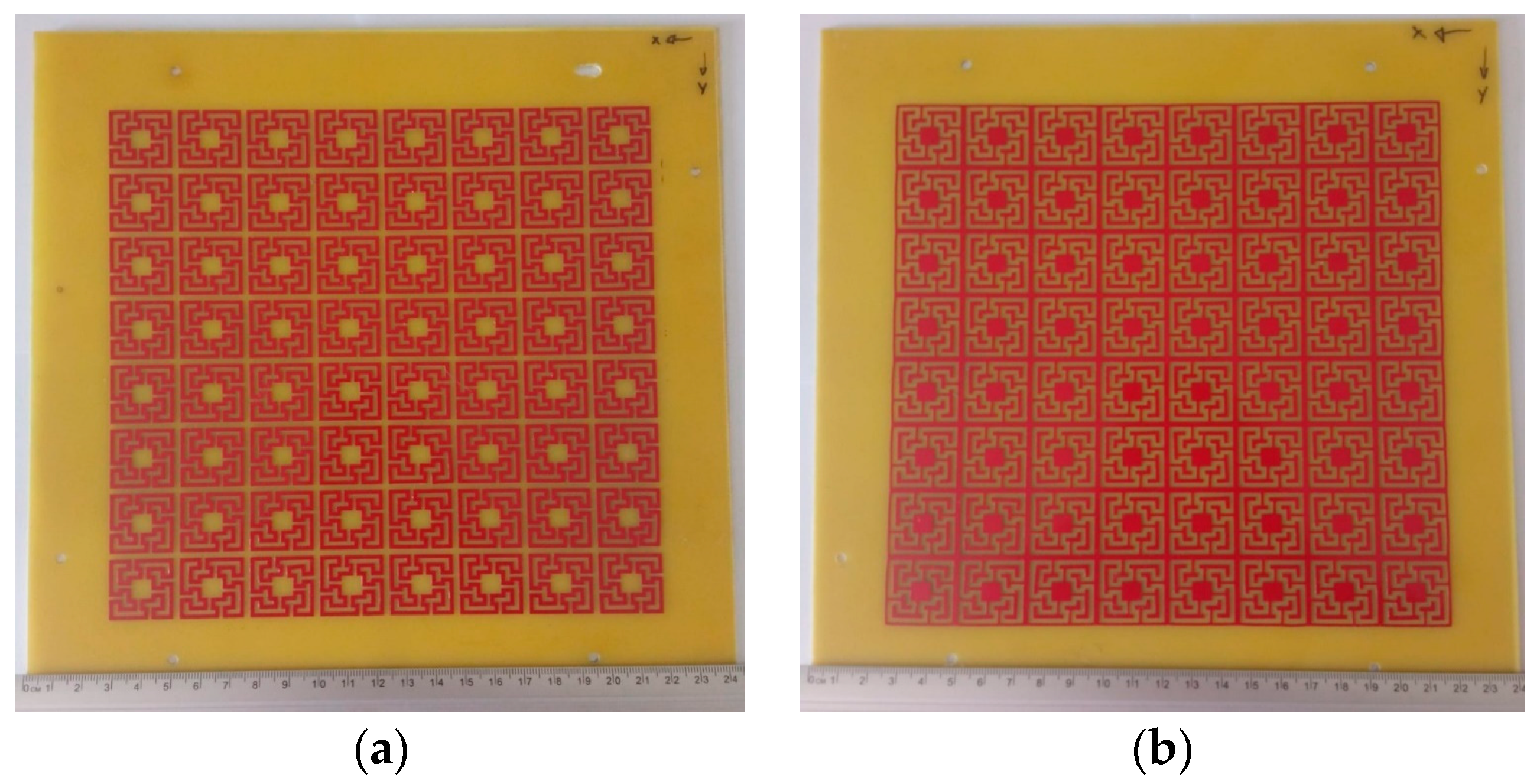



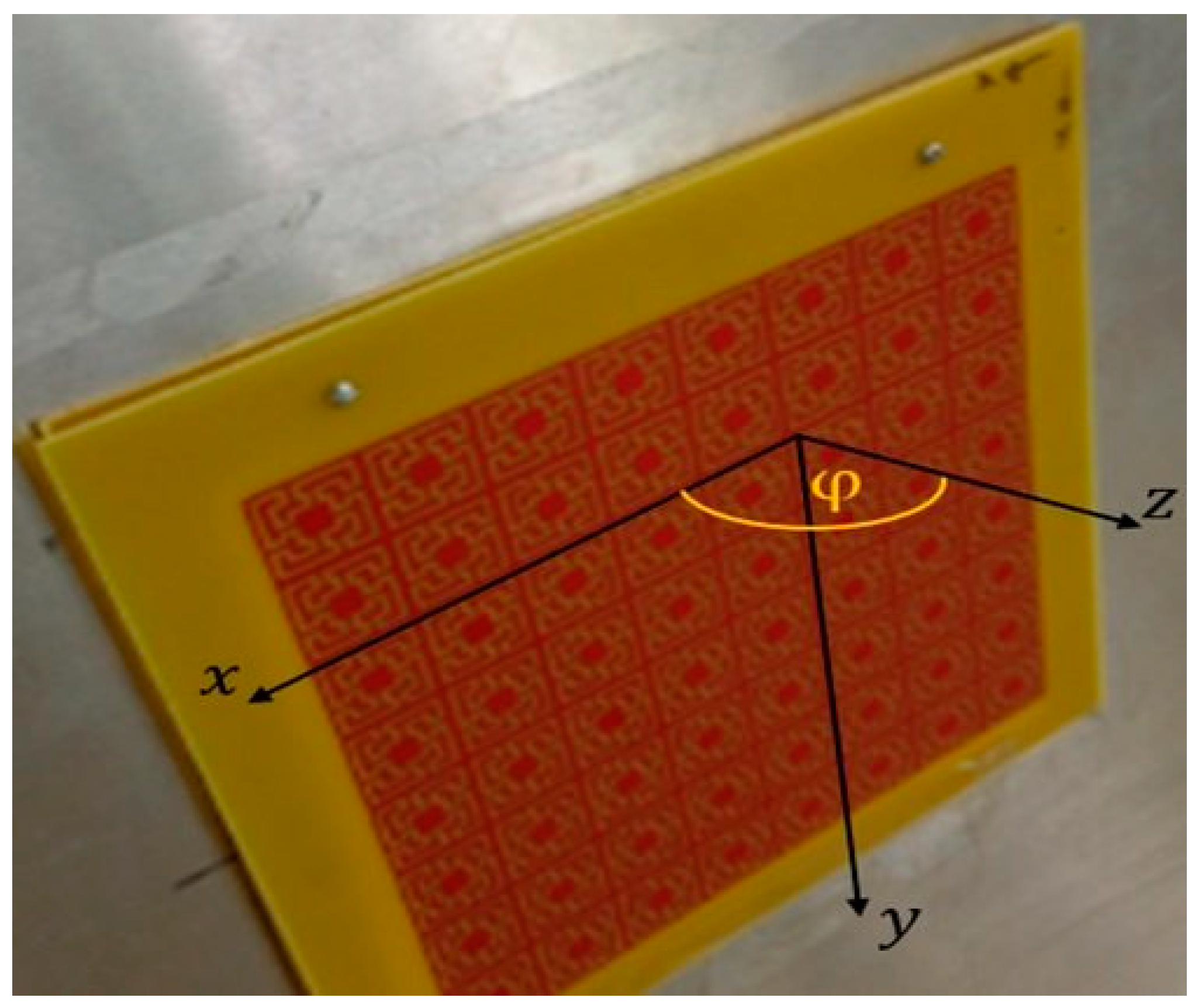

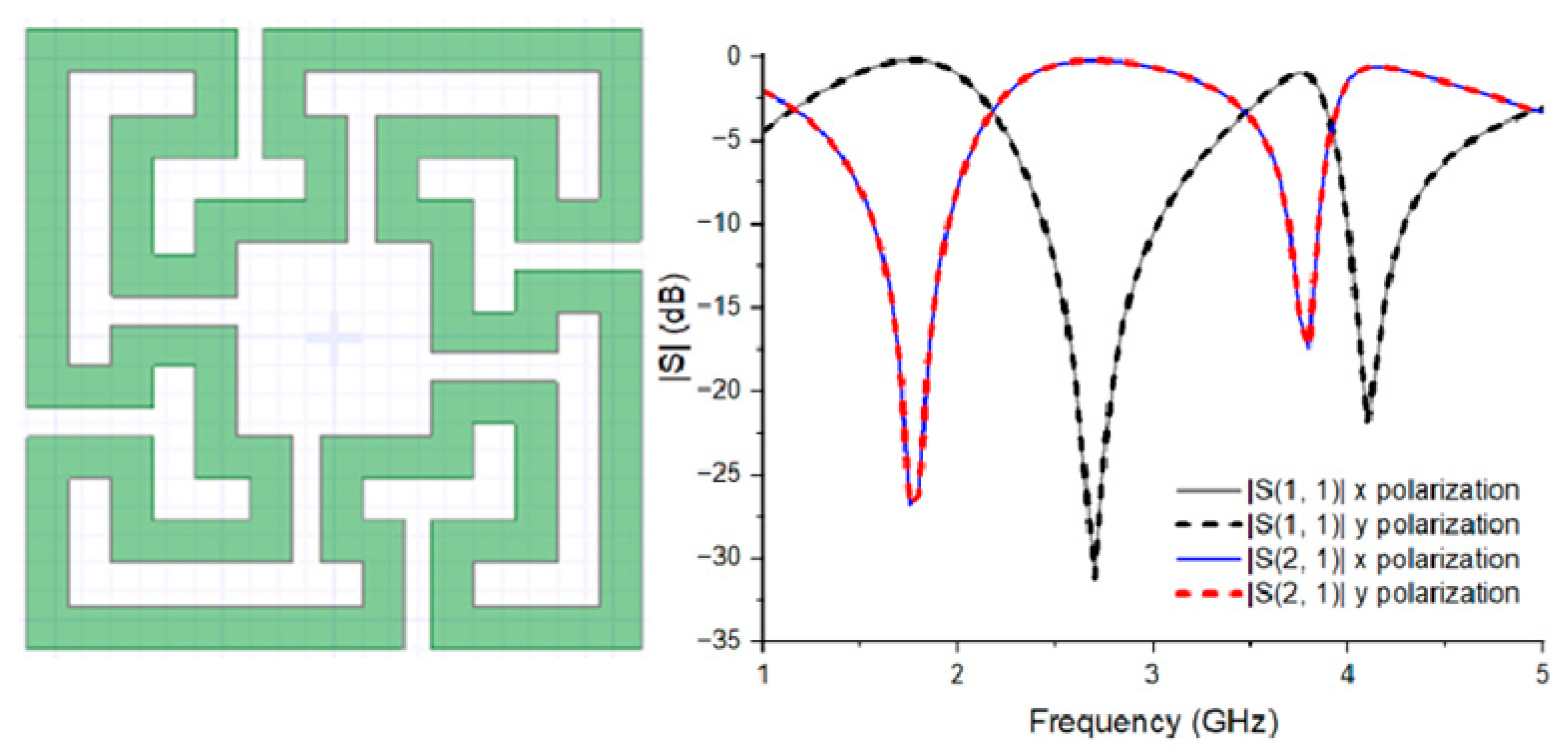
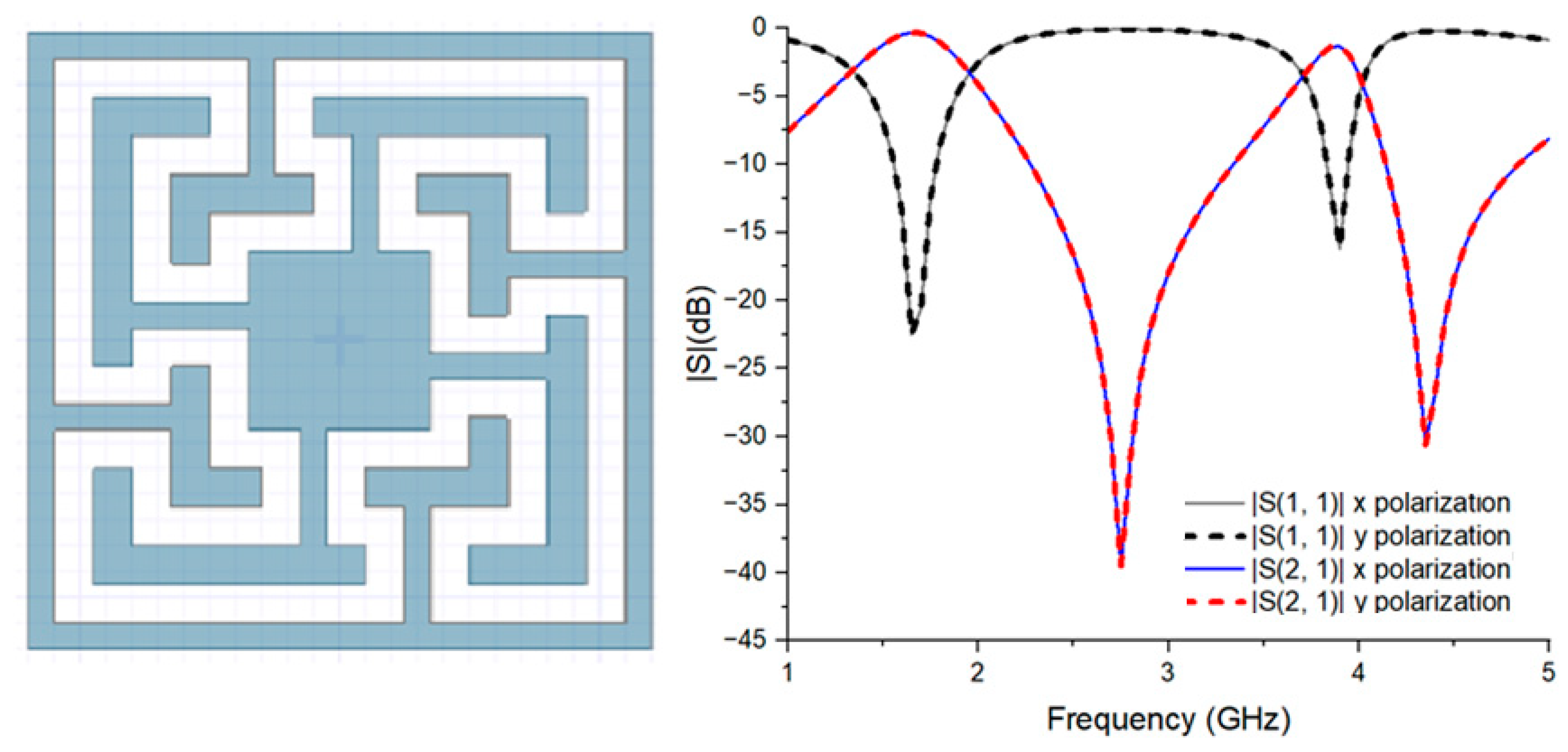
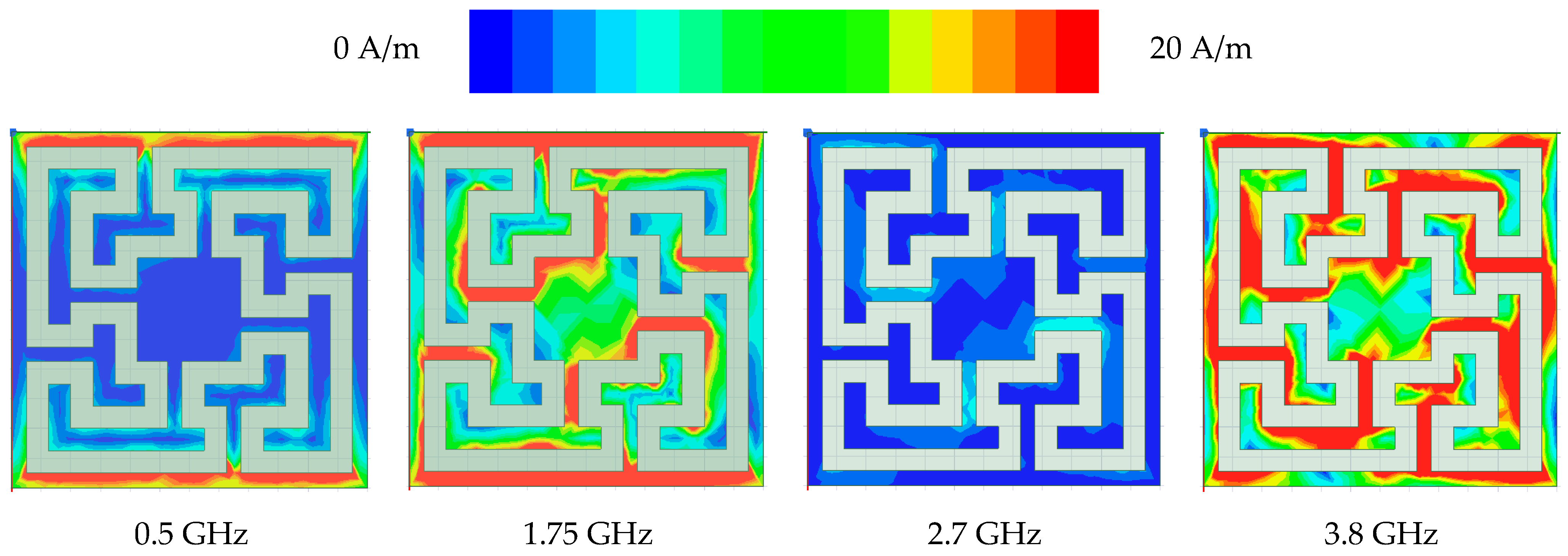
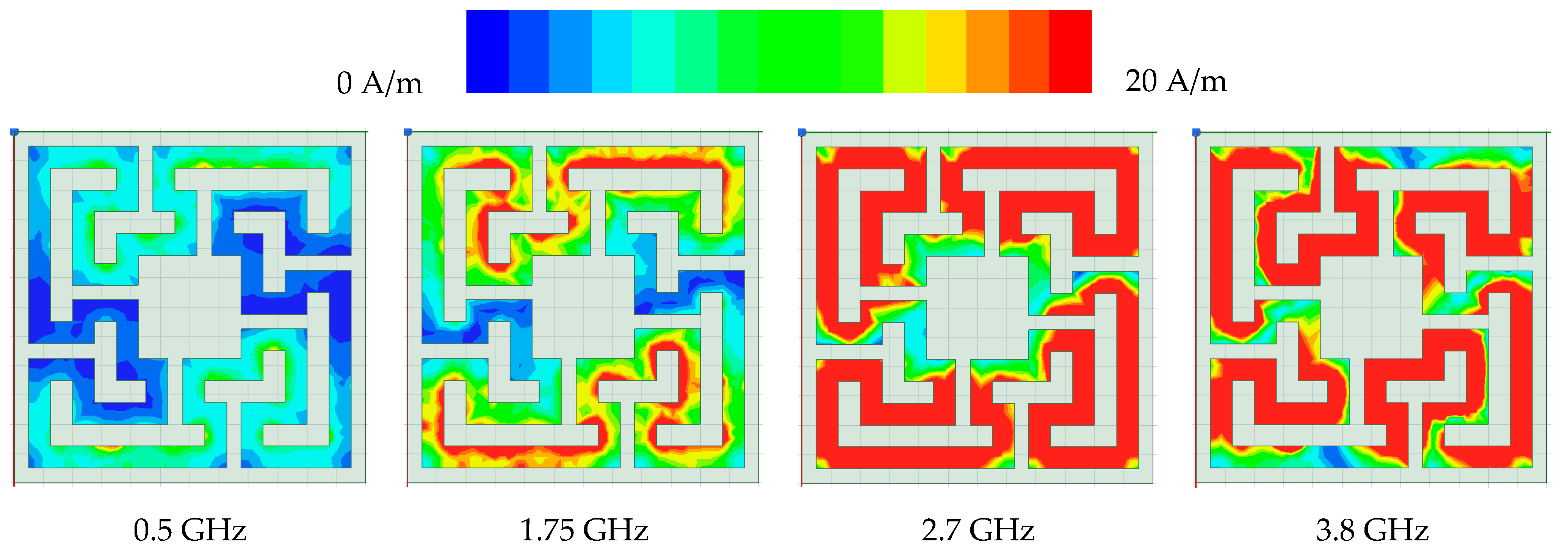
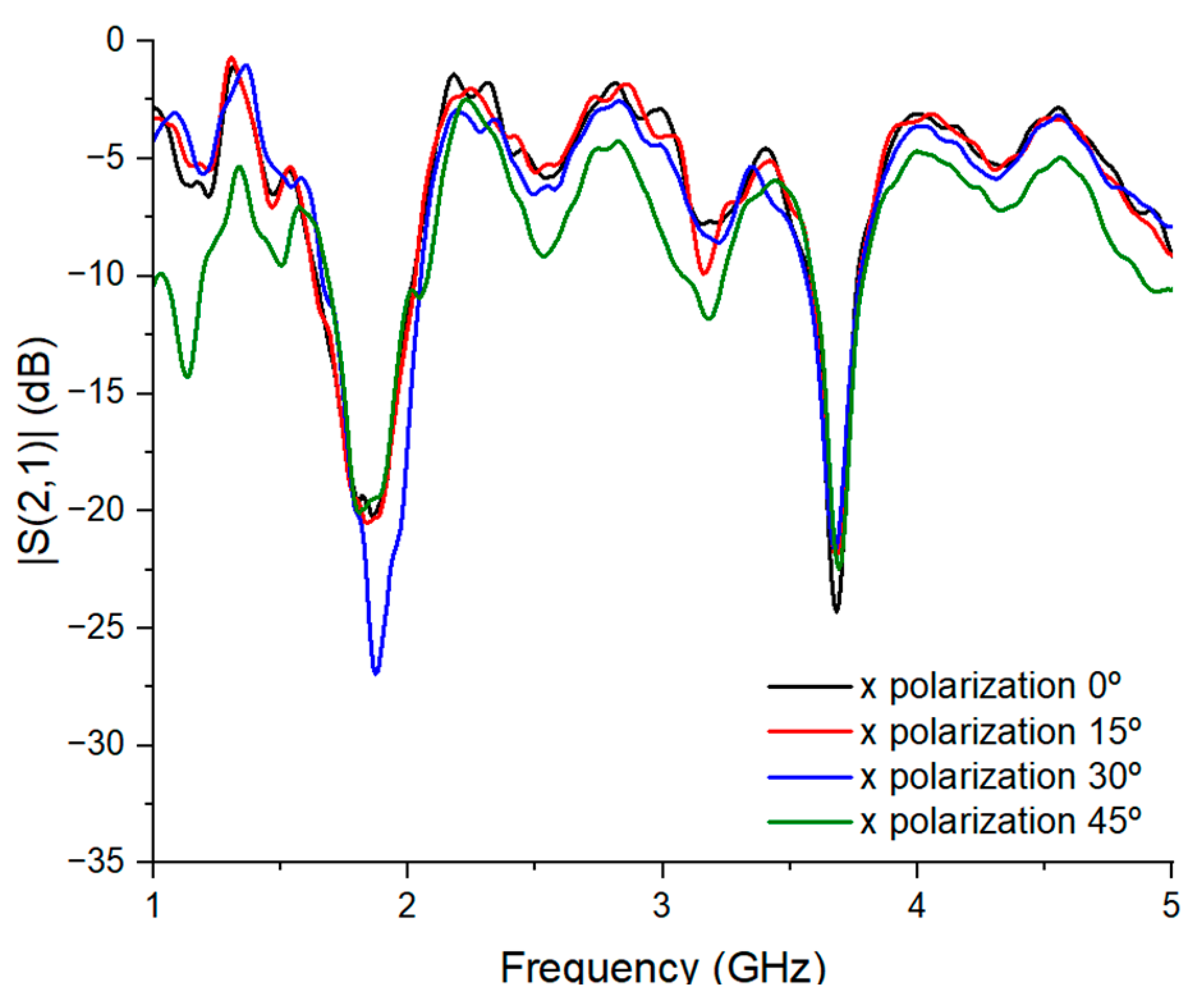
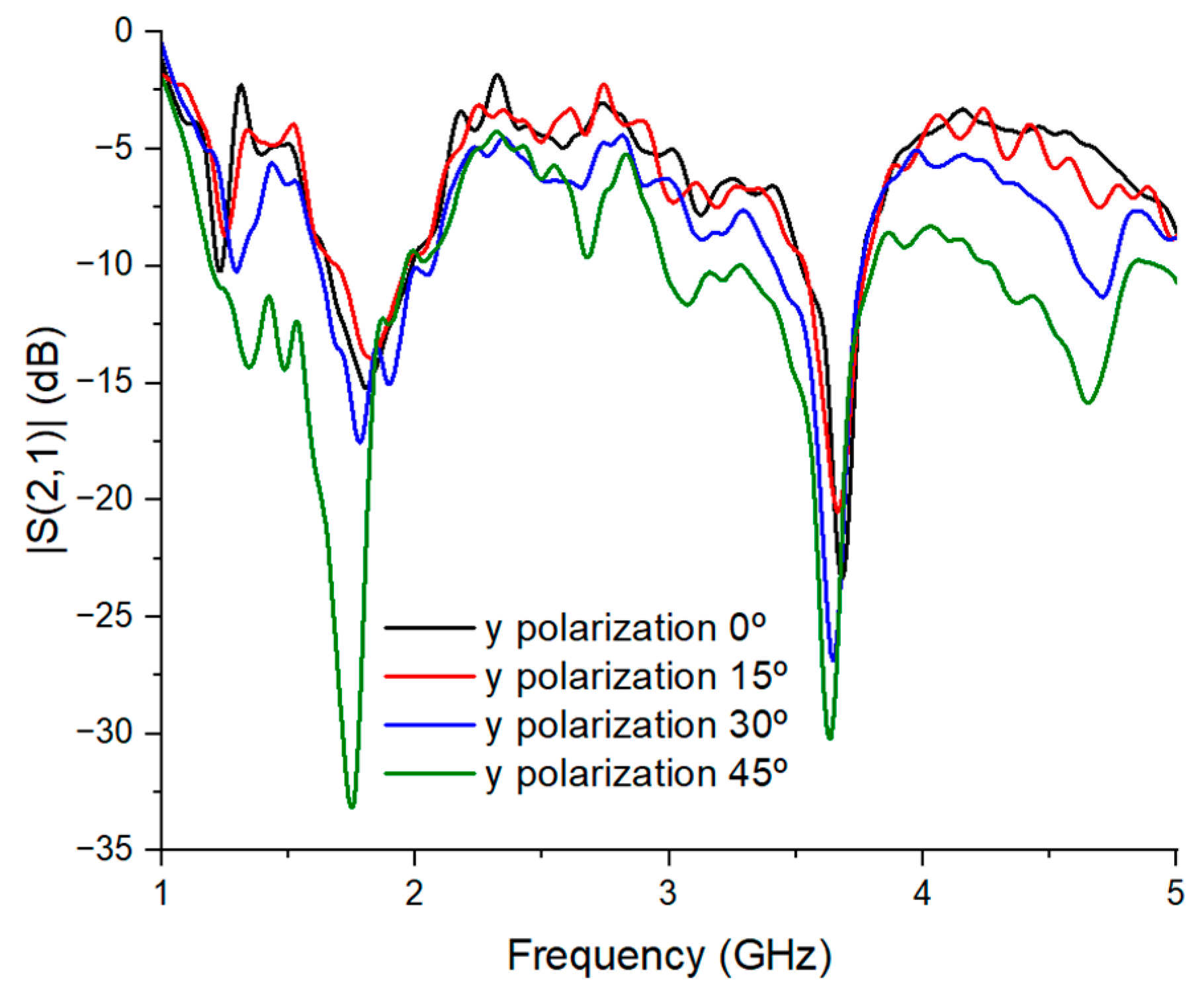
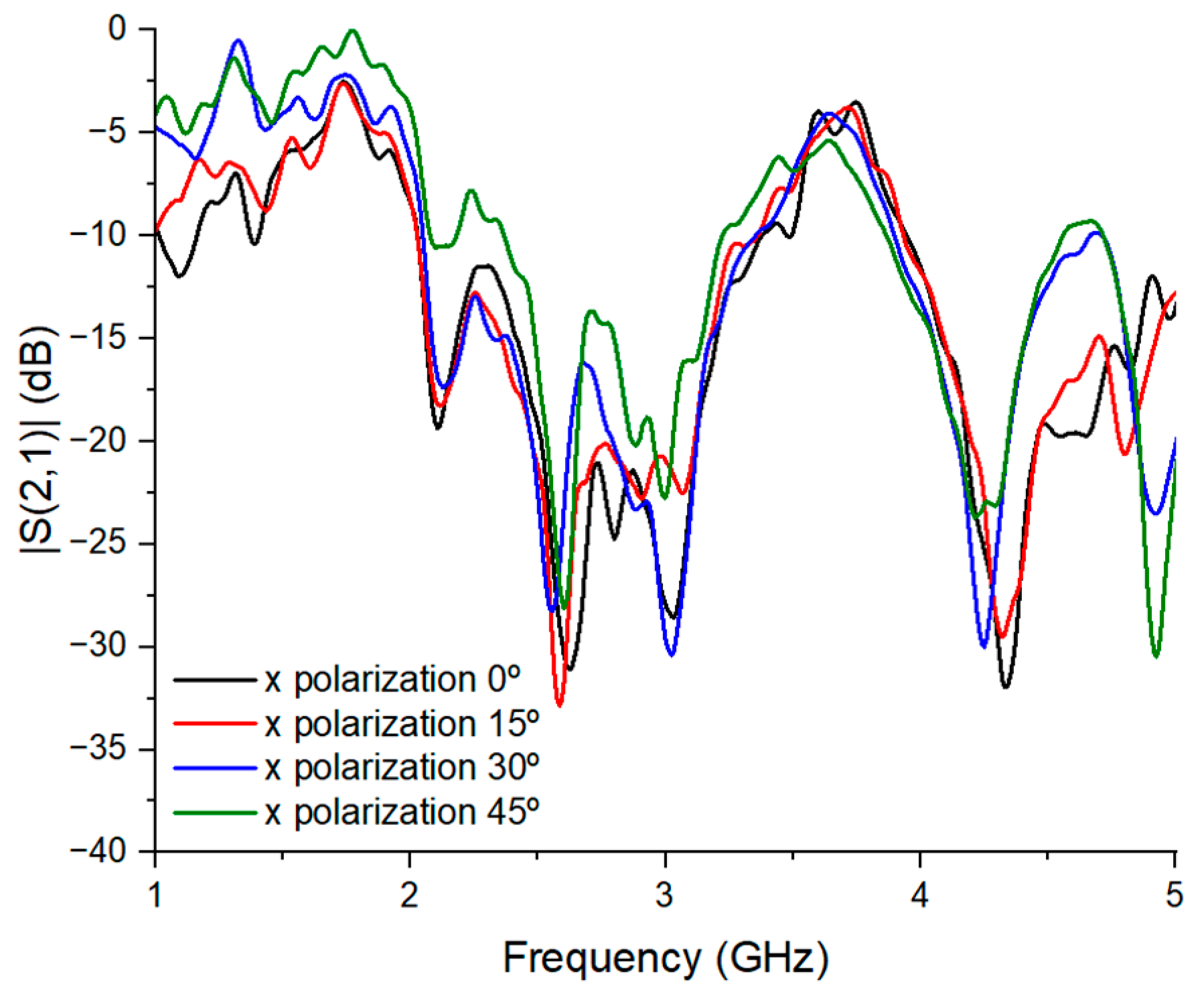

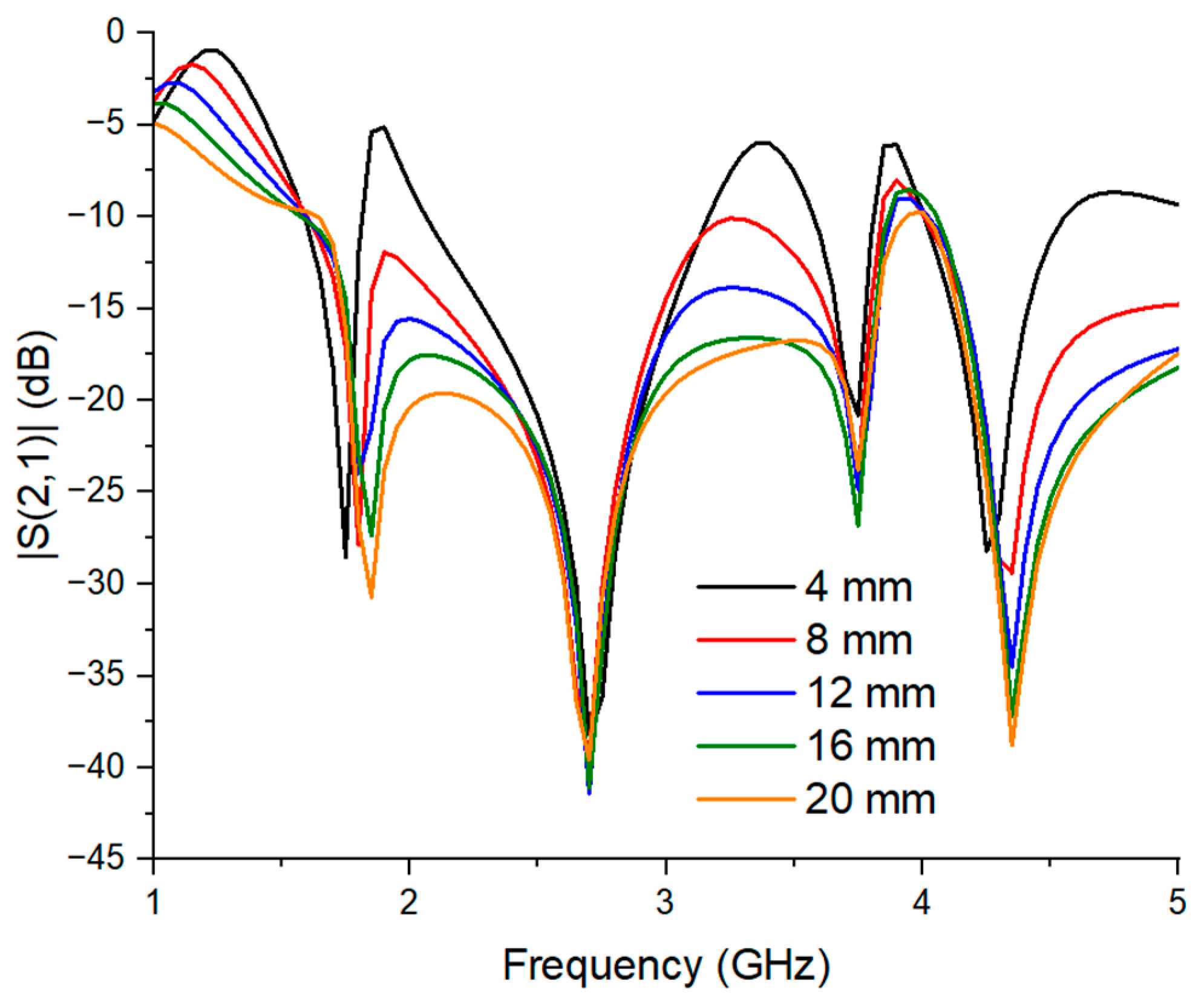



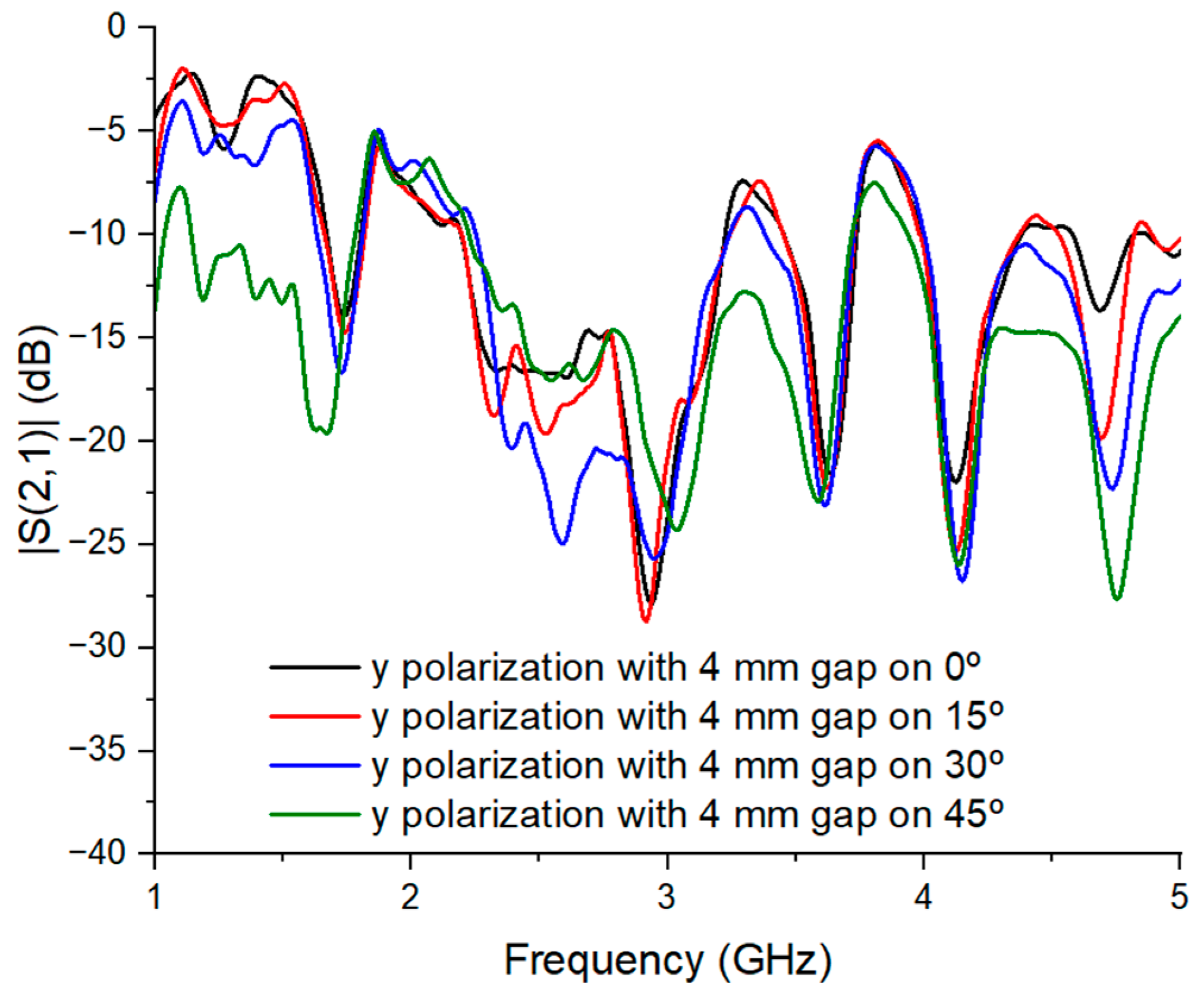



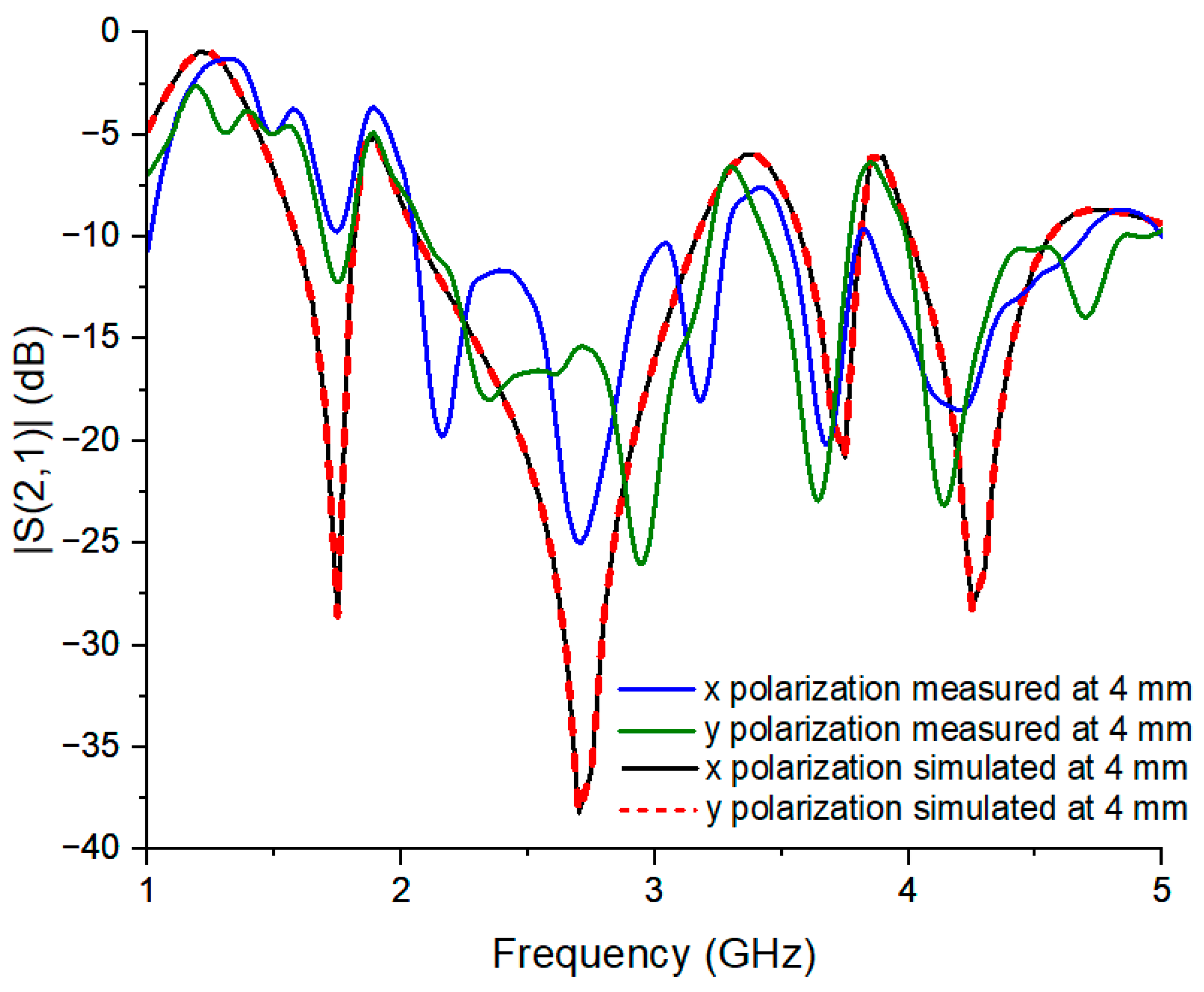

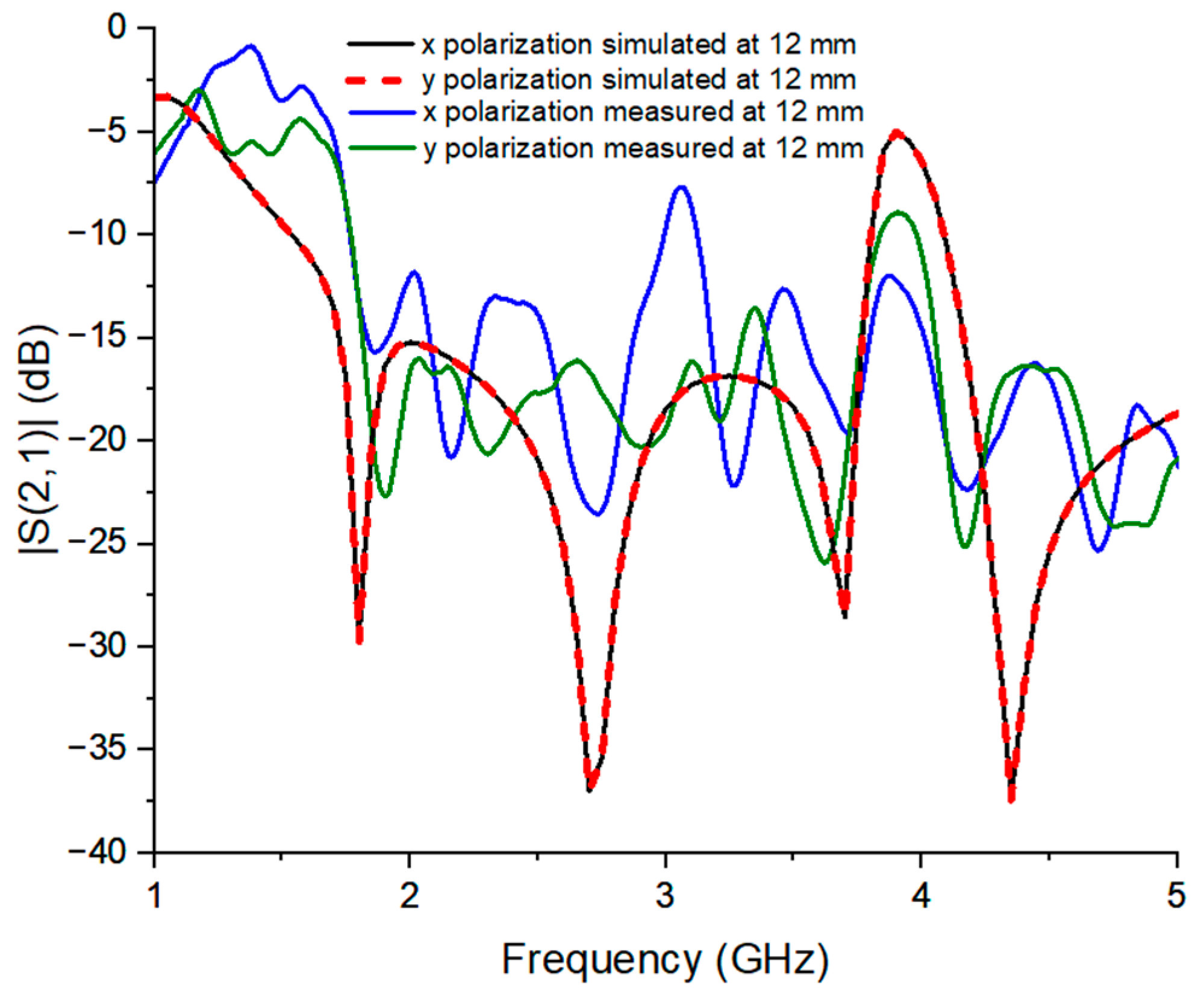
| Reference | Bandwidth | Geometry |
|---|---|---|
| [16] | 2.4–2.5 and 4.98–5.825 GHz | Fractal |
| [17] | 2.48–6.13 GHz | Square ring (4 layers) |
| [18] | 3.10–10.60 GHz | Dual square rings (2 layers) |
| [19] | 3.10–10.60 GHz | Patch with slots (3 layers) |
| [20] | 1.8–2 GHz and 2–2.8 GHz | 3D square rings |
| [21] | Around 10 GHz | 4-pointed flower |
| [22] | 0.1 THz to 3.78 THz | Patch (3-layer) |
| Reference | Contribution of the Cascaded FSS with Matryoshka Geometry |
|---|---|
| [16] | Higher bandwidth and reaches lower frequencies |
| [17] | Fewer layers, easier to fabricate materials |
| [18] | Four times less spacing between layers |
| [19] | Fewer layers and less spacing in total between layers |
| [20] | Higher bandwidth and easier to fabricate |
| [21] | Easier to fabricate with lower frequencies reach |
| [22] | Easier to fabricate, fewer layers and application on the GHz range |
| Dimension | Measurement (mm) |
|---|---|
| Cell horizontal size () | 24 |
| Cell vertical size () | 24 |
| Outer square ring () | 22 |
| Middle square ring () | 16 |
| Inner square ring () | 10 |
| Gap () | 1 |
| Stripe width () | 1.5 |
Disclaimer/Publisher’s Note: The statements, opinions and data contained in all publications are solely those of the individual author(s) and contributor(s) and not of MDPI and/or the editor(s). MDPI and/or the editor(s) disclaim responsibility for any injury to people or property resulting from any ideas, methods, instructions or products referred to in the content. |
© 2024 by the authors. Licensee MDPI, Basel, Switzerland. This article is an open access article distributed under the terms and conditions of the Creative Commons Attribution (CC BY) license (https://creativecommons.org/licenses/by/4.0/).
Share and Cite
Coutinho, I.; Madeiro, F.; Queiroz, W. Cascaded Frequency Selective Surfaces with Matryoshka Geometry for Ultra-Wideband Bandwidth. Appl. Sci. 2024, 14, 8603. https://doi.org/10.3390/app14198603
Coutinho I, Madeiro F, Queiroz W. Cascaded Frequency Selective Surfaces with Matryoshka Geometry for Ultra-Wideband Bandwidth. Applied Sciences. 2024; 14(19):8603. https://doi.org/10.3390/app14198603
Chicago/Turabian StyleCoutinho, Ianes, Francisco Madeiro, and Wamberto Queiroz. 2024. "Cascaded Frequency Selective Surfaces with Matryoshka Geometry for Ultra-Wideband Bandwidth" Applied Sciences 14, no. 19: 8603. https://doi.org/10.3390/app14198603






